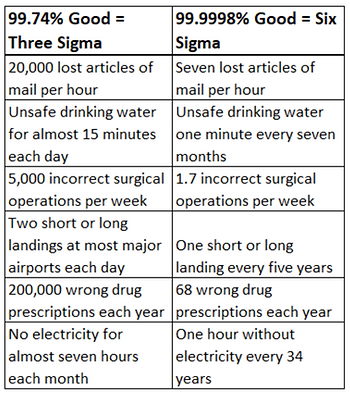What is Six Sigma?
- William Cross
- Oct 20, 2021
- 2 min read
Updated: Apr 21, 2022
Let us pretend you are in charge of mass producing a product for the market and someone comes up to you and offers a way to have 3.4 defects per million products. Would you take it? Of course, you would! That’s nearly a 100% success rate for a fully functional quality product. Since 1980, people have been attaining this rate of success by utilizing a methodology called Six Sigma. It was developed by Bill Smith who was a reliability engineer at Motorola Corporation. His reasoning was due to the increasing chances of system failure rates from increasingly complex products used by consumers. Every process has several working components that work together to accomplish the same goal and Six Sigma strives to bring each components’ failure rate to zero.
As each working component attains a nearly 100% success rate, the results overall are improved, profitability is enhanced, and operating costs are utilized more effectively. A primary objective to reach this level of success is focusing on reducing variation by taking the right actions effectively and using customer data as a roadmap before such actions are made. There are two categories of variation: controlled and uncontrolled. Controlled variation are the internal variables of a process that are required for the product or service to be completed. Uncontrolled variation is external to the process and does not aid the production. This is a simple distinction to be made but the purpose of defining our categories is for Six Sigma practitioners to know their process inside and out and respond accordingly to the nature of process improvement.
Having a production process reach almost zero defects per million opportunities is a display of quality. Another way of describing quality is understanding it as a ‘non-faulty system’. After all, if there is fault in the product or service, the consumer will not spend money to purchase it and will go to a competitor instead. Thus, a system is developed in which there are defined boundaries for a process to navigate by. This development is brought out by using statistical process control techniques, data analysis methods, and project management techniques. A well-known tool in Six Sigma is the DMAIC, which stands for Define, Measure, Analyze, Improve, and Control, which we will not get into during this article. Overall, Six Sigma is a methodology that encompasses these skills and tools with a heavy reliance on mathematical computations.
We have gone over the theoretical implications of Six Sigma, but now let us see real world examples of Six Sigma at work.

As you can see, the importance of quality and value of Six Sigma is displayed in just one chart. I hope this was an informative intro to Six Sigma and sparks interest in your process improvement endeavors.
The following resource were used to write this article:
Lean Six Sigma – Process Improvement Tools and Techniques by Donna C.S. Summers
